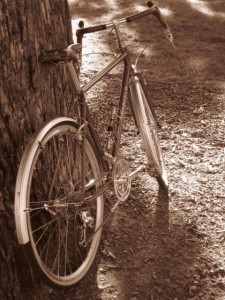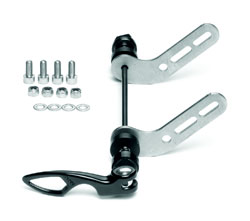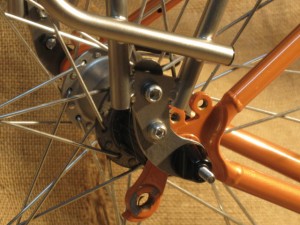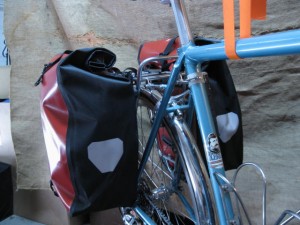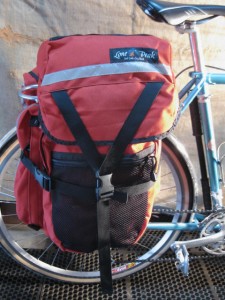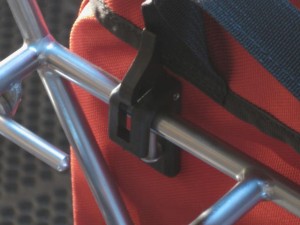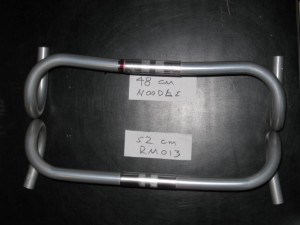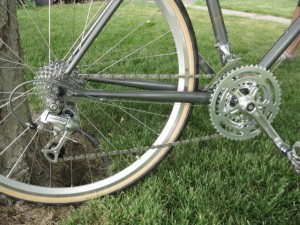
August 1, 2011
It’s only about 46 miles from Fay Bainbridge State Park to Fort Worden State Park in Port Townsend. By the time we were finished riding on the day we had covered 58 miles.
After a few miles on the scenic pastoral backroads we were back to the treacherous 305. Crossing the Agate Pass Bridge on a bicycle is not for the timid. Sky King went first and did it exactly the way it should be done. Timing her entry in front of a big box van, she rode in the traffic lane, since there is no shoulder, and the truck slowed to follow her across, with traffic backing up behind. There is no choice but to hold up traffic in situations like this and most people are not psychopaths and they will not, usually, mow down a bicycler.
Immediately after crossing the bridge we took a right onto Suquamish Way up to Suquamish and to Port Gamble. Winding back roads with low traffic brought us to the town of Port Gamble where we stopped for lunch. Then we were on the ACA West Coast route up to Fort Townsend.

We passed by Fort Townsend State Park south of town because it was our intention to stay at Fort Worden State Park. It is not evident on reaching Fort Worden that any camping is even offered. We rode around the barracks and other buildings and found a campsite but the sign said pre-registration was a requirement and that the campground was full anyway. I flagged down a passing vehicle and the driver told us the office was closed but directed us to the hiker-biker camping area. A network of trails connects primitive campsites for tent campers all of which were available except for one which contained a tent already pitched. We stopped at site adjacent to this one to leave our bikes and reconnoiter the area.
A man of normal build and maybe 40 years, wearing basketball shorts, a t-shirt, gym shoes, a short hair cut and a goatee walked passed us and said, “How’s it goin?” in a voice that was maybe a little too loud and forced, before he turned into the next campsite which apparently was his.
“Fine” I replied.
We could still hear him talking and as we continued past his site we saw him standing on the bench of his picnic table facing away from the trail towards the woods and reading aloud from the bible. We thought that was a little different and looked for a site as far away as possible. When we came back to retrieve our bikes he had changed his demeanor and was assuring some person who remained unseen that,
“They are all f****** liars. They’re all f******* liars and they aren’t going to get away with it.”
When our eyes met his words to me were,
“Yeah, I’m talkin’ to you”
We secured our bikes and gear and took them and exited out of the other end of the hiker-biker area. We rode down to the beach camp ground which was also full. I told a passing city cop about the incident in the hiker-biker area. We saw him again a few minutes later and he told us he had spoken to the park ranger who was going to have a talk to the individual, and who was not happy that we felt too threatened to stay in his park. Both the city cop and the park ranger took us seriously and they were concerned about keeping the area safe and so I’m sure this was an isolated incident.
As we were riding back towards Fort Townsend State Park I couldn’t help but feel sorry for this fellow. I can’t even imagine what it must be like to live inside his scrambled head, but it must be terrifying. He might have been a high functioning schizophrenic but still he doesn’t have a lot of choice but to scuffle around and try to find someplace to stay until he gets run off. There are not really any social services for these poor people. I don’t know what can or should be done for them but it’s really sad.
Adjacent to the boatyard, through which runs the bike path, the Port Townsend Brewing Company is located just off Haines Place on 10th Street. This is just a tasting room with no food but the beer is good and there are nearby places to eat. After doing our due diligence here, we proceeded to the Safeway across the street and bought a baked, whole chicken and some broccoli to take back with us to Fort Townsend State Park, where we ate and collapsed into our sleeping bags.















